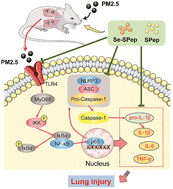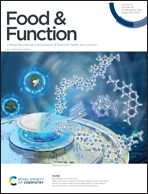Selenium-enriched soybean peptides pretreatment attenuates lung injury in mice induced by fine particulate matters (PM2.5) through inhibition of TLR4/NF-κB/IκBα signaling pathway and inflammasome generation
Abstract
This study aimed to identify and prepare peptides from selenium (Se)-enriched soybeans and determine whether dietary Se-enriched soybean peptides (Se-SPep) could inhibit lung injury in mice induced by fine particulate matter 2.5 (PM2.5). BALB/c mice were randomly divided into six groups. The mice in the prevention groups were pretreated with 378 mg kg−1 of Se-SPep, soybean peptides (SPep), and Se-enriched soybean protein (Se-SPro), respectively, for four weeks. The mice in the PM2.5 exposure group received concentrated PM2.5 (15 μg per day mice) for 1 h daily from the third week for two weeks. The results showed that the leukocyte and cytokine (IL-1β, IL-6, TNF-α) levels in the bronchoalveolar lavage fluid (BALF) of the PM2.5 exposure group were higher than those in the control group. Se-SPep pretreatment decreased the IL-1β, IL-6, and TNF-α levels compared with the PM2.5 exposure group. Additionally, Se-SPep pretreatment inhibited TLR4/NF-κB/IκBα and NLRP3/ASC/caspase-1 protein expression in the lungs. In conclusion, Se-SPep pretreatment may protect the lungs of the mice against PM2.5-induced inflammation, suggesting that Se-SPep represents a potential preventative agent to inhibit PM2.5-induced lung injury.



 Please wait while we load your content...
Please wait while we load your content...